
The DDL 1745M (1975)
By 1975, integrated circuit technology had advanced to the point that Random Access Memory (RAM) chips became commercially available. For audio delay, this was a game-changer. Instead of being limited to shifting bits into one end of a delay line and waiting for the bits to emerge from the end of the line, audio could be ‘stored’ in memory and recalled at will. The 1745M was unlike anything that existed and for many, DDLs were still a mystery. Here’s how the Instruction Manual introduced it to audio pros and studio maintenance engineers: “…this is an unusual instruction manual”.

The DDL1745M represented a significant advance and became the industry standard for delay. It was mono in but could be configured with up to 5 independently controlled delay outputs. A single voice could turn into a chorus.
You Got an “M” not an “A”
The 1745M replaced the 1745A after only a year or so, and Page 1 of the Instruction Manual begins:
“YOU HAVE JUST PURCHASED AN EVENTIDE MODEL 1745M DIGITAL DELAY LINE. IF BY SOME CHANCE YOU WERE EXPECTING AN EVENTIDE 1745A DIGITAL DELAY LINE, DON’T COMPLAIN.”
It goes on to explain why starting with “it weighs less!”

By the time of the introduction of the 1745M, ‘digital’ was still a new concept but no longer a complete mystery. The Instructional Manual included “The Digital Delay Line REVISITED” which began with a bit of nostalgia, “Remember when the Digital Delay Line was new?”
“M” Stands for Memory
After discussing the limitations of using shift registers for delay, “it’s like a pipeline”, Random Access Memory (RAM) is described as “like a book”. Humans could now, for the first time, non-destructively read and write high fidelity audio at will and nothing would ever be the same. RAM’s ability to “store individual chunks of data, and deliver them upon demand” ushered in a new world. Our world today.

RAM made high resolution, single sample, delay possible. The ‘resolution’ of a shift registered based delay was constrained by the time it took audio to pass through each shift register. In the case of the 1745 and 1745A, that was 2 msec. The 1745M’s delay resolution was one sample, 20 usec – 100X finer! Users would flip a switch on the module and spin the knob to dial in the amount of delay with extreme precision with LED displaying the precise time in fraction of a msec.
In an alternate Universe “M” might have stood for “Modular”
While the “M” stood for memory, the 1745M chassis was a modular design with 5 slots holding up to 5 output modules. The standard 1745M shipped with 2 delay output modules but users could install up to a total of 5 independent delay modules. With the 1745Ms 5 outputs, a mono source could create a chorus of five voices or be used as a multitap delay to add ambience to a track.
Flipping the Switches and Spinning a Knob
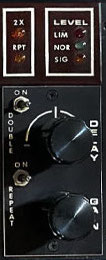
RAM also made two key features instantly available with a pair of front panel toggle switches—“Double” and “Repeat.” Flipping these switches while turning the delay knob made digital looping possible for the first time
Here’s how those two toggle switches worked: The “Double” switch instantly cut the sample rate in half, thereby doubling the amount of delay. The “Repeat” switch (the term we previously used, “Recirculation,” was too long to print on the front panel) allowed the user to instantly capture any audio currently stored in memory and play it back as an endless loop.
Users quickly discovered that flipping the “Double” switch after capturing a loop would play the loop back at half speed with the audio shifted down by an octave. Alternately, turning Double on first and then Repeat would play a longer loop AND then turning Double off would cause the loop to play back at twice the speed and the audio would play back shifted up by an octave. Flipping those two switches and twisting the delay knob while looping open up a whole new bag of creative tricks.
The “M” Brings a New Bag-O-Tricks
The 1745M data sheet touted additional new effects made possible by the RAM-based design — flanging, pitch change, comb filtering, tunneling, recirculation, and reverb. The data sheet teases, “if that’s not enough” and goes on to describe a completely different type of innovation – automation.

The Instruction Manual put it this way “If you think that you just bought a delay line, think again” and encouraged the user to do “strange and wondrous things to their unsuspecting signals.”

Repeat & Tunneling
RAM-based “Repeat” took on a new meaning. Shift-register-based “Repeat” was constrained to be ‘fixed’. The playback of the captured signal was always the entire loop. The 1745M’s RAM-based approach allowed for any length, any segment, of stored audio to be looped over and over again. And, for the first time, a digital device could play the captured audio in ‘reverse’ and ‘get things which nobody knows about’ like tunneling – ‘The origin of the term is obscure..’.
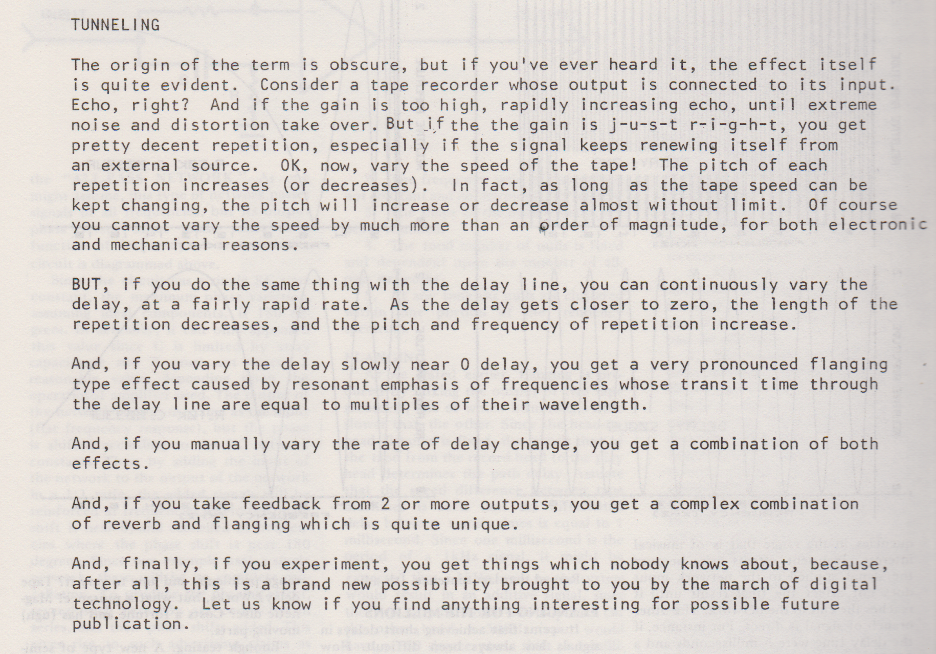
The Optional Pitch Change Module
In 1976, Richard, with Tony looking over his shoulder and dreaming of a keyboard pitch changer, designed a 2-slot wide Pitch Change module.
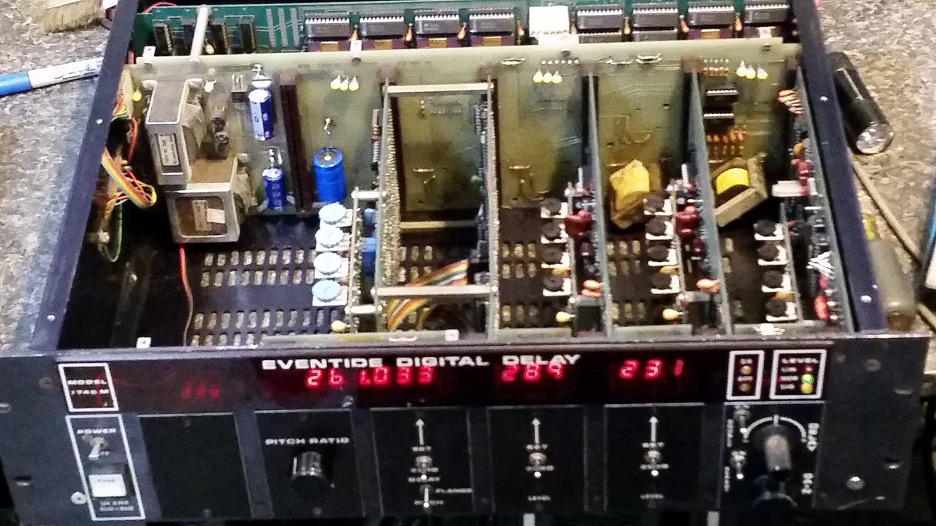
The Pitch Change Promise
The Instruction Manual described the challenges in designing a pitch changer but declares that by April of that very year (1976) a Pitch Change Module would be available and making the bold claim that “all (of) these problems are curable” – well “mitigated” was more like it! With the pitch change option installed, the 1745M became the world’s first electronic pitch shifter for musical applications.
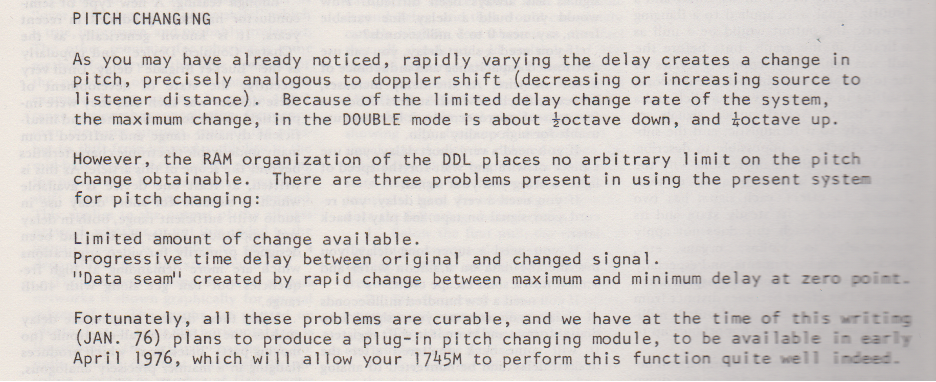
The Untold Stories
The Instruction Manual included a “Theory of Operation” but left out a few tantalizing tidbits. One was secret, one embarrassing, and one not known at the time of publication.
The Secret! The Pitch Change module was inspired by the availability of a chip called a FIFO, or first-in first-out memory. It was pretty obscure and probably became obsolete within a few years as technology improved. But it would store a number of bytes of memory using one clock and read them out using a different clock. By reading two samples from the RAM sample memory every 20 microseconds you could read them out twice as fast, doubling the pitch. But since you were reading them in once every sample period, you would run out of samples quickly. The genius of the FIFO was the “half-full” flag. If it was running out of data, the flag would demand more, reading two samples at a time. If there was too much data, i.e., reducing pitch, it would stop collecting samples from the memory. By keeping the FIFO approximately half-full, one could adjust the output sample clock from a pitch ratio of .5 to 2.0 without disturbing the input sample rate.
The Embarrassing! Why did the 1745M weigh so much less? Aluminum. The earlier 1745 and 1745A used these wonderful military-surplus power transformers that we were able to obtain on New York’s “Radio Row.” Bullet-proof and reliable, but very heavy, and with, as it turns out, exactly the right primary windings for 115 and 230V and even a boost-buck winding that was good for Japan’s 100VAC power. 50Hz? No problem. And cheap! Eventually we couldn’t get them anymore and designed the 1745M with standard parts that weighed a lot less. No more steel chassis to support the transformer! Oh yes, those goofy round AC connectors? Radio Row!
The Unknown! What about MIDI control of the delay time for the newfangled “automation” just coming to studios? Great idea, but MIDI didn’t exist! So, anti-prophetically, we selected the IEEE-488 protocol used for test equipment that was invented by Hewlett-Packard. We built a remote-control module using a Motorola microprocessor and IEEE-488 chip. Worked beautifully! Too bad MIDI came along, although we did sign up. Our SysEx number is just a bit higher than that of Apple.
The Honest Truth
As for the ‘cure’, the pitch change method, while certainly usable, was far from perfect. Its “Limitations” were matter-of-factly described thus “…(it) isn’t perfect. Well, nothing is, really…” and specifically described the results as being “Under most circumstances…not obnoxious.”
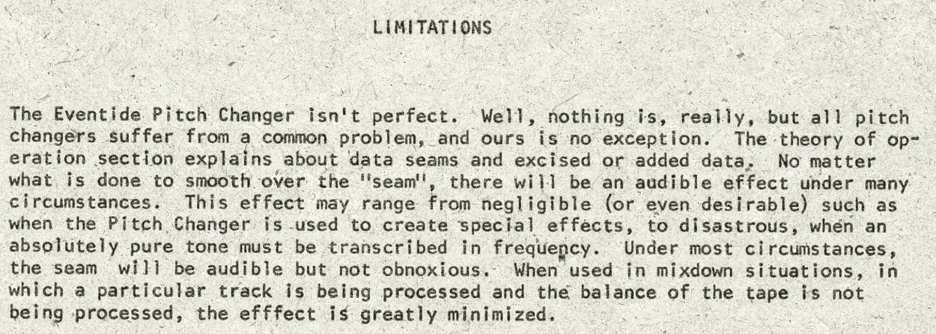
Despite its shortcomings, the 1745Ms pitch changer was used on hundreds of records. Here’s Barry Gibbs smiling with a 1745M with Pitch Change Option sitting over his shoulder.

We’re Just Getting Started
Some of the 1745Ms new effects were summarized under “General Weirdness”:

DDL 1745M Deep Dive
Click here for everything we could find in our archives about the DDL 1745M and click here to read the original 1745M user manual.
The 1745M was the third and final of the 1745-series DDLs. Next month’s flashback? Richard Nixon’s role in the invention of the Omnipressor. Stay tuned.
Check out our previous flashbacks!
- Flashback #1: The Instant Phaser
- Flashback #2.1: The DDL 1745 Delay
- Flashback #2.2: The DDL 1745A Delay
- Flashback #2.3: The DDL 1745M Delay
- Flashback #3: The Omnipressor®
- Flashback #4.1: The H910 Harmonizer®
- Flashback #4.2: H910 Harmonizer® — The Product
- Flashback #4.3: H910 Harmonizer® — “Minds Blown”
- Flashback #5: FL 201 Instant Flanger
- Flashback #6: HM80 — The Baby Harmonizer®
- Flashback #7.1: The H949 Harmonizer®
- Flashback #7.2: H949 Harmonizer® — The New One
- Flashback #7.3: H949 Harmonizer® — Bending, Stretching, and Twisting Time
- Flashback #8: H969 Harmonizer®
- Flashback #9.1: Broadcast
- Flashback #9.2: Dump & Go – The Profanity Delay
- Flashback #10: Thinking Outside the Black Box


